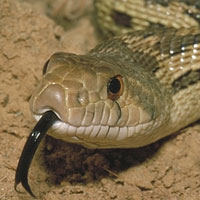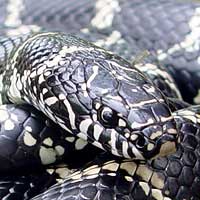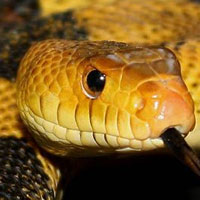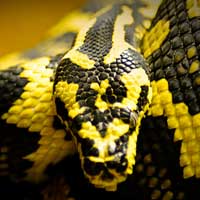Exploring the Unique World of the Trans-Pecos Rat Snake
The Trans-Pecos Rat Snake, scientifically known as Bogertophis subocularis, belongs to the Colubridae family, which is the largest family of snakes, encompassing a wide variety of non-venomous and mildly venomous species known for their adaptability and diverse habitats across the globe.
Scientific Name: Bogertophis subocularis
Snake Family: Colubridae
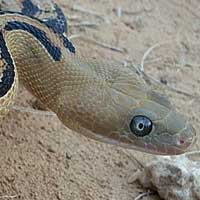
Introduction to the Trans-Pecos Rat Snake
The Trans-Pecos Rat Snake (*Bogertophis subocularis*), native to the arid regions of West Texas and northern Mexico, is renowned for its calm demeanor and striking appearance. Featuring large eyes and a pattern of blotches on a tan or cream background, this snake is a popular choice for reptile enthusiasts. With proper care and habitat, the Trans-Pecos Rat Snake thrives in captivity, making it an excellent option for both novice and experienced keepers.
Crafting the Perfect Habitat for the Trans-Pecos Rat Snake
Replicating the natural environment of the Trans-Pecos Rat Snake is key to its well-being. These snakes inhabit rocky deserts and arid grasslands in the wild. Consider the following for a proper setup:
- Enclosure Size: A 40-gallon tank or larger is recommended for adults.
- Temperature Gradient: Maintain daytime temperatures of 75-85°F, with a basking spot at 90°F, and nighttime temperatures of 65-70°F.
- Humidity: Keep humidity levels between 30-50% to mimic their arid habitat.
- Substrate: Use sand-soil mixes, aspen shavings, or desert-specific substrates.
- Enrichment: Provide climbing branches, rocks, and multiple hides for exploration and security.
Below is a habitat setup reference table:
| Habitat Element | Specifications |
|---|---|
| Enclosure Size | 40+ gallons |
| Temperature | 75-85°F (day), 65-70°F (night) |
| Humidity | 30-50% |
| Substrate | Sand-soil mix, aspen shavings, desert substrates |
Feeding the Trans-Pecos Rat Snake: What to Know
The Trans-Pecos Rat Snake is a carnivorous species that primarily feeds on small mammals and birds in the wild. Feeding guidelines for captive care include:
- Juveniles: Feed pinky mice every 5-7 days.
- Subadults: Offer small to medium-sized mice every 7-10 days.
- Adults: Provide adult mice or small rats every 10-14 days.
- Prey Type: Use pre-killed prey to ensure safety and reduce stress during feeding.
- Hydration: Always supply fresh water in a shallow dish for drinking and occasional soaking.
Maintaining a consistent feeding routine supports your snake’s health and vitality.
Understanding the Behavior and Temperament of the Trans-Pecos Rat Snake
The Trans-Pecos Rat Snake is known for its docile and inquisitive nature. Key behavioral traits include:
- Nocturnal Activity: These snakes are primarily active at night, making evening observations most rewarding.
- Climbing Enthusiasts: They are skilled climbers, so vertical space and branches are essential.
- Calm Demeanor: They rarely exhibit defensive behaviors and are generally tolerant of handling.
- Stress Indicators: Signs such as frequent hiding, refusal to eat, or excessive movement may indicate stress.
Providing a calm and enriched environment ensures your snake exhibits natural behaviors and remains stress-free.
Health and Lifespan of the Trans-Pecos Rat Snake
With attentive care, the Trans-Pecos Rat Snake can live 15-20 years in captivity. Important health considerations include:
- Common Issues: Watch for respiratory infections, shedding problems, and mite infestations.
- Preventative Measures: Maintain stable temperature and humidity levels, and keep the enclosure clean.
- Veterinary Care: Annual check-ups with an exotic animal veterinarian are recommended.
- Observation: Monitor for signs of illness, such as wheezing, lethargy, or changes in appetite.
Proactive care and regular health monitoring are key to ensuring a long and healthy life for your snake.
Reproduction and Breeding of the Trans-Pecos Rat Snake
Breeding Trans-Pecos Rat Snakes in captivity requires a controlled environment and proper preparation. Key considerations include:
- Breeding Season: Typically occurs in spring following a winter cooling period.
- Clutch Size: Females lay 5-10 eggs per clutch.
- Incubation: Eggs should be incubated at 80-85°F for 55-65 days.
- Hatchling Care: Provide appropriately sized enclosures and prey for juveniles once they hatch.
Successful breeding requires careful monitoring of both the breeding pair and environmental conditions.
Tips for Handling and Caring for the Trans-Pecos Rat Snake
Handling and caring for the Trans-Pecos Rat Snake is straightforward when following these guidelines:
- Handle your snake gently, supporting its entire body to minimize stress.
- Avoid handling immediately after feeding to prevent regurgitation.
- Keep the enclosure clean and enriched to mimic natural behaviors.
- Provide consistent interaction to build trust and reduce handling-related stress.
- Monitor health and behavior to detect and address issues early.
With proper care and attention, the Trans-Pecos Rat Snake can thrive and provide years of fascination and enjoyment.
Other Snakes In This Species
 Aesculapian Rat Snake
Aesculapian Rat Snake Amur Russian Rat Snake
Amur Russian Rat Snake Bairds Rat Snake
Bairds Rat Snake Black Rat Snake
Black Rat Snake Chinese Twin-spotted Rat Snake
Chinese Twin-spotted Rat Snake Diadem Rat Snake
Diadem Rat Snake Diones Rat Snake
Diones Rat Snake Eastern Fox Snake
Eastern Fox Snake Everglades Rat Snake
Everglades Rat Snake Four-lined Rat Snake
Four-lined Rat Snake Gray Rat Snake
Gray Rat Snake Great Plains Rat Snake
Great Plains Rat Snake Green Rat Snake
Green Rat Snake Ladder Rat Snake
Ladder Rat Snake Leopard Rat Snake
Leopard Rat Snake Mandarin Rat Snake
Mandarin Rat Snake Radiated Rat Snake
Radiated Rat Snake Steppes Rat Snake
Steppes Rat Snake Texas Rat Snake
Texas Rat Snake Trans-Pecos Rat Snake
Trans-Pecos Rat Snake Trinket Rat Snake
Trinket Rat Snake Yellow Rat Snake
Yellow Rat Snake



